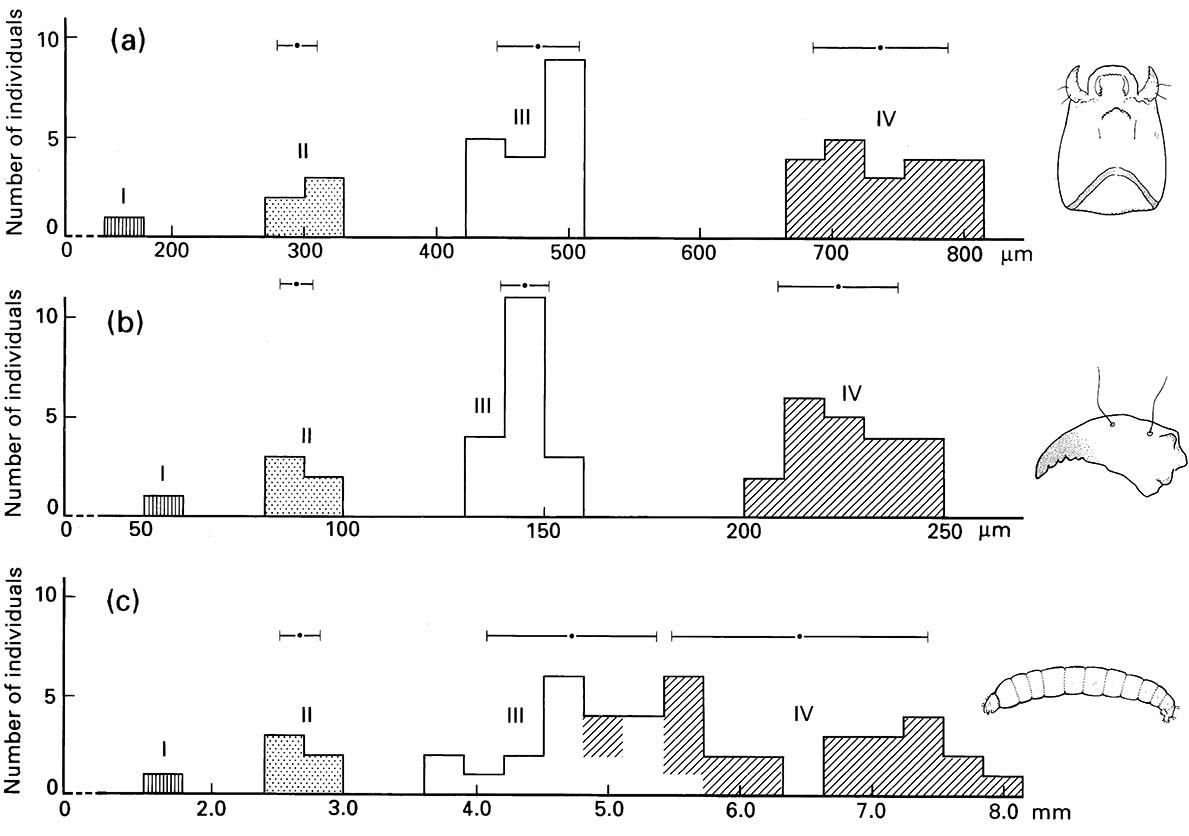6.9.1. Age-grading of immature insects
For many population studies it is important to know the number of larval or nymphal instars in a species and to be able to recognize the instar to which any immature individual belongs. Generally, such information is available or its acquisition is feasible for species with a constant and relatively small number of immature instars, especially those with a lifespan of a few months or less. However, it is logistically difficult to obtain such data for species with either many or a variable number of instars, or with overlapping generations. The latter situation may occur in species with many asynchronous generations per year or in species with a life cycle of longer than one year. In some species there are readily discernible qualitative (e.g. color) or meristic (e.g. antennal segment number) differences between consecutive immature instars. More frequently, the only obvious difference between successive larval or nymphal instars is the increase in size that occurs after each molt (the molt increment). Thus, it should be possible to determine the actual number of instars in the life history of a species from a frequency histogram of measurements of a sclerotized body part (Fig. 6.11).
Entomologists have sought to quantify this size progression for a range of insects. One of the earliest attempts was that of H.G. Dyar, who in 1890 established a “rule” from observations on the caterpillars of 28 species of Lepidoptera. Dyar’s measurements showed that the width of the head capsule increased in a regular linear progression in successive instars by a ratio (range 1.3–1.7) that was constant for a given species. Dyar’s rule states that:
postmolt size/premolt size (or molt increment) = constant
Thus, if logarithms of measurements of some sclerotized body part in different instars are plotted against the instar number, a straight line should result; any deviation from a straight line indicates a missing instar. In practice, however, there are many departures from Dyar’s rule, as the progression factor is not always con- stant, especially in field populations subject to variable conditions of food and temperature during growth.
A related empirical “law” of growth is Przibram’s rule, which states that an insect’s weight is doubled during each instar and at each molt all linear dimensions are increased by a ratio of 1.26. The growth of most insects shows no general agreement with this rule, which assumes that the dimensions of a part of the insect body should increase at each molt by the same ratio as the body as a whole. In reality, growth in most insects is allometric, i.e. the parts grow at rates peculiar to themselves, and often very different from the growth rate of the body as a whole. The horned adornments on the head and thorax of Onthophagus dung beetles discussed in section 5.3 exemplify the trade-offs associated with allometric growth.

(a) head capsule length; (b) mandible length; and (c) body length between the four larval instars (I–IV). The dots and horizontal lines above each histogram represent the means and standard deviations of measurements for each instar. Note that the lengths of the sclerotized head and mandible fall into discrete size classes representing each instar, whereas body length is an unreliable indicator of instar number, especially for separating the third- and fourth-instar larvae.

